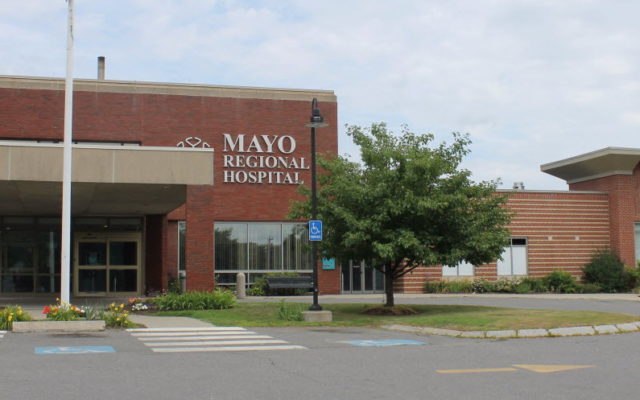
Maine hospitals and the state prepared for a much more intense COVID-19 pandemic
Click here for the latest coronavirus news, which the BDN has made free for the public. You can support our critical reporting on the coronavirus by purchasing a digital subscription or donating directly to the newsroom.
As health care systems in coronavirus hot spots are stretched thin, Maine hospitals and the state prepared for a much larger onslaught of coronavirus cases than the one that has materialized so far here.
Hospitals added critical care beds and ventilators for a potential uptick in patients diagnosed with COVID-19, the disease caused by the new coronavirus. The state mobilized volunteers with medical expertise who could staff hospitals if they became overwhelmed, and it planned for two overflow sites if hospitals ran out of capacity.
But Maine seems to have flattened the coronavirus curve enough — reducing numbers of new cases — that hospitals haven’t needed to tap into those resources to respond to the coronavirus pandemic, according to state officials. Maine’s statewide stay-at-home order, bans on large gatherings, the closure of many nonessential businesses and other physical distancing precautions have kept Mainers apart from each other, limiting their ability to transmit the highly contagious virus. On Tuesday, Gov. Janet Mills renewed many of those restrictions and introduced a phased-in approach to reopening the state’s economy.
[Our COVID-19 tracker contains the most recent information on Maine cases by county]
One direct result is that alternative care sites planned for arenas in Bangor and Portland to handle overflow from area hospitals haven’t even been set up yet, and they might not be needed at all, according to Maine Center for Disease Control and Prevention spokesman Robert Long.
Announced at the start of the month, the Cross Insurance Center in Bangor planned to treat non-coronavirus patients who still needed some level of hospital care, while the site at the Portland Cross Insurance Arena planned to treat coronavirus patients who didn’t need acute care.
“We are positioned and ready if and when there is a need to begin setting up the alternative care sites,” Long said in an email. “To date, Maine hospitals have continued to have sufficient capacity to care for patients.”
The number of people hospitalized for the coronavirus has been declining over the past two weeks. As of Monday, 39 people statewide were hospitalized with the coronavirus, a 36 percent drop from two weeks earlier when 61 people were hospitalized on April 13.
At the same time, hospitals have more resources available to treat serious cases, as they’ve redeployed staff to be ready to treat virus cases and added critical care beds and ventilators over the past month.
On April 1, hospitals reported to the Maine CDC that they had 272 critical care beds total that could handle cases needing intensive treatment. By Tuesday, that number had grown to 330 as some hospitals converted existing beds to intensive care unit beds.
Similarly, on April 1, Maine hospitals reported 348 total ventilators and 128 alternative ventilators — a total of 476. Almost a month later, they reported 315 ventilators and 397 alternative ventilators, totaling 712.
But less than 5 percent of the state’s critical care beds were being used to treat coronavirus patients on Monday, according to the Maine CDC. And seven people who tested positive for the coronavirus were on ventilators, using less than 1 percent of the state’s total.
Brewer-based Northern Light Health, which has 10 hospitals spread throughout the state, said last week it’s actually using fewer critical care beds and ventilators than it normally does because its hospitals — like hospitals across the country — have stopped many non-coronavirus operations and procedures.
As for staffing, the state hasn’t had to tap its corps of Maine Responds medical volunteers to report for duty to hospitals, even as health care workers have accounted for about a fifth of the state’s confirmed cases and the state has enlisted more volunteers. However, long-term care facilities that have been hard hit by coronavirus outbreaks are starting to use University of Maine System nursing students and professors to make up for dwindling staffs as more of their employees test positive for the coronavirus and others choose not to work out of fear of becoming infected.
Coordination is one reason the state’s hospitals have been prepared for a surge in cases that hasn’t come yet, said Dora Mills, a former Maine CDC director and chief health improvement officer for the Portland-based hospital system MaineHealth.
The state’s four largest hospital systems — Northern Light, MaineHealth, Augusta-based MaineGeneral Health and Lewiston-based Central Maine Healthcare — have communicated weekly with each other and the Maine CDC since the start of the pandemic, said Mills, who is also the governor’s sister. The Maine Hospital Association often represents hospitals not affiliated with those systems in those conversations, she said.
“In between and among the health systems, we’re also able to share information and collaborate, coordinate and communicate very effectively,” she said. “I think that’s also been a major factor in being able to preserve our resources.”
While the added capacity to treat coronavirus patients might not be needed right now, Mills said it is important to maintain it in case Maine sees a spike in cases that some experts anticipate later in the year. There is a lot unknown about the virus in terms of immunity, reinfection and what will happen after social distancing rules are relaxed.
“The reason why we’ve been able to preserve our health care system is because of all the social distancing that every person and organization is doing,” Mills said. “We have to maintain quite a bit of surge capacity within our health care systems because we did not see a big surge, which was great news. But we need to be careful that we don’t.”